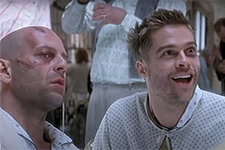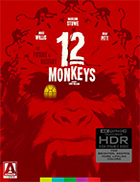12 Monkeys (4K UHD)
|  Terry Gilliam’s 12 Monkeys was the idiosyncratic auteur’s second science fiction film—the first being his contentious masterpiece Brazil (1985)—and the second to be made from a script he had no hand in writing. Following the success of the The Fisher King (1991), which bore many of his stylistic and thematic hallmarks, but was clearly more mainstream than anything he had made before, 12 Monkeys was an intriguing foray into high-concept genre territory, but with Gilliam’s inimitable, slightly twisted sensibility. Like The Fisher King and unlike all his previous films, it did not feature any former members of Monty Python, the British comedy troupe for which Gilliam had written sketches and supplied animation in the late 1960s and early ’70s. It was also set in both the present day (circa the early 1990s) and a dystopic near future ravaged by a virus that has wiped out nearly all of humanity, rather the fantastical imaginary worlds of films like Monty Python and the Holy Grail (1975), Jabberwocky (1977), and Time Bandits (1981). Scripted by David Peoples (Blade Runner, Ladyhawke) and his wife, Janet Peoples, 12 Monkeys borrows its basic plot structure from Chris Marker’s experimental 1962 film La Jetée, which was told almost entirely with still images—a photo essay with a plot. 12 Monkeys, on the other hand, is a film of almost constant movement, with Gilliam and cinematographer Roger Pratt turning the film into a master class of tracking shots and extreme angles. In this regard it is very similar visually to Brazil, which garnished its totalitarian nightmare-future with similarly extreme style (Pratt shot both films, as well as The Fisher King and Tim Burton’s Batman [1989]). Bruce Willis plays James Cole, a convict in the year 2030 who is chosen to go back in time, not to stop the virus, but merely to discover its cause so the people of the future can understand it and develop a vaccine for it. The first time he is sent back, he is accidentally sent to 1990, six years prior to when he was supposed to arrive. Of course, a bedraggled man who claims to be from the future talking about a virus that will wipe out humanity is immediately put into a mental hospital, where he meets two extremely important people who will shape his own future (and the future of humanity): Jeffrey Goines (Brad Pitt), a garrulous schizophrenic who we later learn is the son of a prominent virologist (Christopher Plummer), and Dr. Kathryn Railly (Madeline Stowe), a psychiatrist in to whose care James is entrusted. Dr. Railly is, like the other medical professionals at the hospital, sure that James is simply delusion, but events will later occur that cause her to take his story more seriously. The film skips back and forth through time, with numerous sequences set in the post-virus future where the remains of humanity have moved underground (these scenes are the most Gilliam-esque, as they are adorned with his peculiar brand of baroque hardware and extreme industrial set design). The sequences set in the present reflect the desolation of the looming future, with most of the action occurring either within the walls of the grungy mental institution or on the streets of Philadelphia, where James must live while trying to figure out where the virus will start, which eventually leads him to an extremist animal rights group known as the Army of the Twelve Monkeys. The desperation driving James has less to do with trying to save the future of humanity and more to do with his own desperate self-preservation. He is haunted by a memory from his childhood when he watched a man being gunned down by police in an airport, which punctuates the film at various points, its brightly lit visuals standing in stark contrast to the rest of the film’s dour darkness. Thus, death surrounds James at all turns—in his past and his future. For Gilliam, 12 Monkeys was an opportunity to infuse what might otherwise have been a mainstream sci-fi thriller with his unique artistic sensibility, which makes the film feel like a fever dream and marks it as a high point in Gilliam’s troubled Hollywood career, when he was fully able to deliver an accessible film that still felt distinctly his. The plot is convoluted, but not unintelligible, and it features outstanding performances. Willis, under Gilliam’s guidance, gives a decidedly non-Bruce Willis performance, eschewing a lot of the familiar mannerisms that audiences loved in the Die Hard films (the third of which came out earlier that year) in favor of something rougher, more desperate and gritty. James is a violent man and at times he loses control of himself, which makes him a complex protagonist. Pitt’s fantastically deranged, tic-laden performance as the demented Jeffrey Goines was one of a number of roles he took in the early ’90s that demonstrated his range and versatility and his refusal to play by the rules. While he could clearly play handsome leading-man material in films like A River Runs Through It (1992) and Legends of the Fall (1994), which helped land him People magazine’s coveted moniker of “Sexiest Man Alive” in 1994, he also took on challenging, anti-social roles like the drawling, redneck serial killer in Kalifornia (1993) and a comically stoned slacker in True Romance (1993). Pitt’s Oscar nomination for his role here was clear validation of his acting prowess, even if it repeated the Academy’s penchant for rewarding attractive actors for playing unattractive roles. Nevertheless, Pitt’s performance is all of a piece with the film, which is at once haunting, humorous, nerve-wracking, and ambitious—one of Gilliam’s best.
Copyright © 2022 James Kendrick Thoughts? E-mail James Kendrick All images copyright © Arrow Video | |||||||||||||||||||||||||||||
Overall Rating: 


 (3.5)
(3.5)


